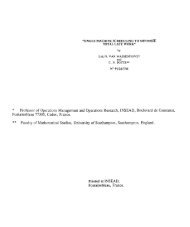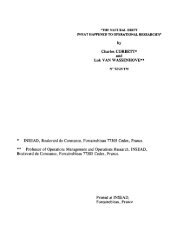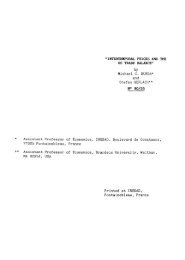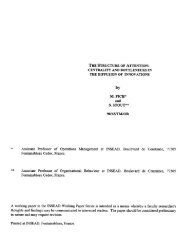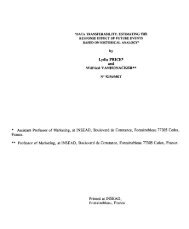* Assistant Professor of Operations Management at INSEAD ...
* Assistant Professor of Operations Management at INSEAD ...
* Assistant Professor of Operations Management at INSEAD ...
You also want an ePaper? Increase the reach of your titles
YUMPU automatically turns print PDFs into web optimized ePapers that Google loves.
The present paper generalizes the results <strong>of</strong> the time competition liter<strong>at</strong>ure<br />
in two ways. First, it considers several customer groups with differing<br />
levels <strong>of</strong> imp<strong>at</strong>ience, i.e., it breaks the symmetry <strong>of</strong> the model on the market<br />
side. The result is th<strong>at</strong> the equilibrium is still symmetric on the firm side,<br />
th<strong>at</strong> is, each customer group will be tre<strong>at</strong>ed the same by each firm, or in<br />
other words, firms will not differenti<strong>at</strong>e themselves by focusing on different<br />
market niches. Davidson (1988) is the only one who has addressed this question,<br />
and he finds an equilibrium with firm differenti<strong>at</strong>ion. However, this<br />
result only holds for the case where one customer group has zero imp<strong>at</strong>ience,<br />
in which case one firm will target this group with the lowest price and long<br />
waiting times. The result <strong>of</strong> the present paper is th<strong>at</strong>, as long as all customer<br />
groups have some imp<strong>at</strong>ience, firms with equal capabilities will not choose<br />
such targeting <strong>of</strong> a niche in equilibrium.<br />
Second, this paper introduces incentive issues into the analysis <strong>of</strong> oligopoly<br />
equilibria. These issues were first discussed in a well-known paper by Mendelson<br />
and Whang (1990), in the different setting <strong>of</strong> a service facility within a<br />
firm. The facility - one may think <strong>of</strong> a computing center - serves internal<br />
users with differing service requirements as well as different waiting cost<br />
r<strong>at</strong>es. If individual users' imp<strong>at</strong>ience is only known to themselves upon joining<br />
the system, then incentive comp<strong>at</strong>ibility problems arise: users will feel the<br />
tempt<strong>at</strong>ion to "che<strong>at</strong>" (lie about the degree <strong>of</strong> their imp<strong>at</strong>ience) and "buy<br />
the wrong priority class" in order to reduce their full costs (price plus waiting)<br />
<strong>of</strong> the service. This is the well-known phenomenon th<strong>at</strong> the answer to<br />
the question "How fast do you need a response?" is always "immedi<strong>at</strong>ely."<br />
Mendelson and Whang design a pricing scheme th<strong>at</strong> leads to the overall optimum<br />
and gives each user the incentive to buy the "right" class <strong>of</strong> priority<br />
service (i. e., reveal his/her true waiting cost). In order to implement this<br />
scheme, the firm only needs to know the average service time for each priority<br />
class <strong>of</strong> users. The price then depends quadr<strong>at</strong>ically on the actual service<br />
time <strong>of</strong> each individual user.<br />
The Mendelson and Whang pricing scheme corresponds to welfare maximiz<strong>at</strong>ion<br />
<strong>of</strong> an overall planner. The present paper draws on their analysis<br />
and generalizes the incentive-comp<strong>at</strong>ible contract to an oligopolistic market<br />
equilibrium, where customers' true waiting costs are not known to the firms.<br />
In this case, there is no market equilibrium if the firms continue to charge<br />
the simple linear price as before.<br />
The paper is organized as follows: Section 2 describes our basic industry<br />
model. Section 3 looks <strong>at</strong> the oligopolistic equilibrium when customers' iden-<br />
3






